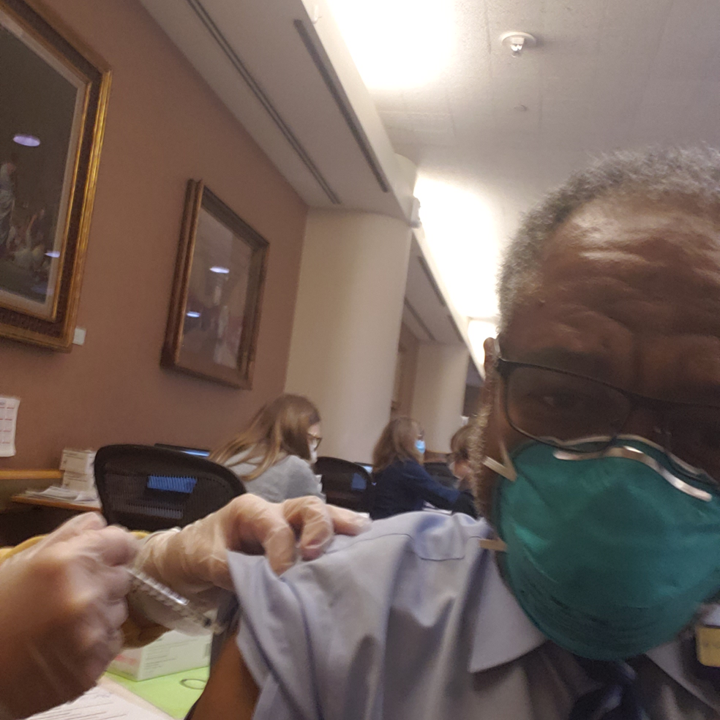We have been recently blessed with the rapid development of vaccines to the COVID-19 (Sars-Cov-2/) virus. However, many people are concerned about the safety of these vaccines. Some are even stating that they will not get themselves vaccinated. This is a major public health problem since we are not likely to get over this COVID-19 epidemic until ~70-80% of the population is vaccinated. Let me therefore give you some honest facts about the three vaccines now approved by our Food and Drug Administration (FDA) for emergency usage in the United States. I got vaccinated and so should you!

First, even though vaccines have been produced by drug companies, the procedures for making a new vaccine and getting it approved by the Federal Government’s Food and Drug Administration (FDA) are numerous and very stringent. Like other FDA approved drugs, any new vaccine must go through several general stages of testing as summarized below:
- Preclinical testing in cells: This is testing in the laboratory, first on cells to make sure the vaccine can be produced without killing or otherwise damaging cells. In the case of the three approved vaccines, this has involved isolating the genetic directions for a portion of the coronavirus (the messenger ribonucleic acid = mRNA), specifically the “spike protein” which it uses to attach to and enter our cells. Of note here is that the genetic directions used cannot make a whole virus, and thus there is no risk of these vaccines causing any COVID infection. Also, as you may have heard, this mRNA approach to vaccine production is new (vs purifying a portion of the virus, which takes much longer and runs the risk of being contaminated with actual viral particles). However, the technology behind such mRNA production of proteins has been around for decades, and we have much experience with the usage and safety of such methods.
- Preclinical testing in animals: Once shown to be safe and efficacious in cells, it is then tested in various laboratory animals using a wide range of doses, again looking for efficacy (ability to produce the designated protein) and safety (all organs and blood are studied for any signs of damage). The final animals tested are usually baboons or monkeys since they are the ones genetically closest to humans. Only those vaccine candidates which past these animal tests are chosen for human study.
- Phase I clinical trial: Here a small number of healthy human volunteers (say 100) are given a vaccine which has been shown safe by the above studies. They start with very low doses, and closely monitor how the drug is spread throughout the body and eliminated, while all the time testing blood and doing various examinations looking for any signs of damage. If no damage is found, then they slowly increase the dose.
- Phase II clinical trial: A vaccine candidate which passes the Phase I stage is now tested in more human volunteers (perhaps hundreds), here among people who might otherwise get COVID infection, to see if there is any prevention of the infection by the vaccine. The study design is usually to give one group the vaccine, the other group an inactive “placebo” vaccine, and compare the infection rate between the two groups. Only if there is demonstrated ability to prevent infection in the real vaccine group and there is no organ damage, does the vaccine advance to Phase III testing.
- Phase III clinical trial: If the results look promising from Phase II, then thousands of individuals are now tested to definitively determine efficacy, while all the time being on the lookout for any organ damage (“adverse reactions” such as severe allergies or need for hospitalization). Only those vaccines which show maximal efficacy with minimal-to-no organ damage are then submitted for FDA approval.
The three U.S. available vaccines: All three vaccines have passed all the above steps. They are summarized below:
- Pfizer/BioNTech: tested in a placebo/vaccine trial in and diverse population of 43,448 humans and shown to be 95% effective in preventing COVID-19 infection (no cases of severe infection requiring hospitalization). This also appears effective against new virus variants. Minimal side effects.
- Moderna: tested in a placebo/vaccine trial in a diverse population of ~30,400 humans and shown to be 94.1% effective in preventing COVID-19 infection (no cases of severe infection requiring hospitalization). This also appears effective against new virus variants. Minimal side effects.
- Johnson & Johnson/Jansen: tested in a placebo/vaccine trial in a diverse population of ~39,321 humans and shown to be ~66.5% effective against getting COVID-19 infection (no deaths among vaccinated group). Minimal side effects.
Post-Phase III ongoing data collection: Once the vaccine receives “emergency use authorization” (the benefits of vaccination greatly outweigh any harm or the vaccine or of contracting COVID) and is administered to millions of individuals, there is still safety monitoring to determine any harm from the vaccine itself.
So now we have data from literally millions of individuals. Although very rare problems have been reported in some vaccinated individuals, it is not yet clear if these problems were due to the vaccination vs. other diseases.
Overall, these vaccines are extremely safe and efficacious. I got my vaccine weeks ago. Please get vaccinated as soon as a vaccine is available to you, help us reach herd immunity and put an end to this epidemic!

